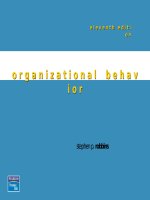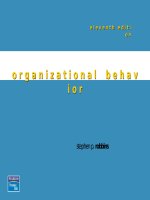OB11 chapter 06 basic motivation concept
Bạn đang xem bản rút gọn của tài liệu. Xem và tải ngay bản đầy đủ của tài liệu tại đây (682.22 KB, 36 trang )
eleventh edition
organizational
behavior
stephen p. robbins
Chapter 6
Basic Motivation
Concepts
ORGANIZATIONAL BEHAVIOR
S T E P H E N P. R O B B I N S
E L E V E N T H
© 2005 Prentice Hall Inc.
All rights reserved.
E D I T I O N
WWW.PRENHALL.COM/ROBBINS
PowerPoint Presentation
by Charlie Cook
OBJECTIVES
After studying this chapter,
you should be able to:
LEARNING
3. Contrast Theory X and Theory Y.
1. Outline the motivation process.
2. Describe Maslow’s need hierarchy.
4. Differentiate motivators from hygiene factors.
5. List the characteristics that high achievers
prefer in a job.
6. Summarize the types of goals that increase
performance.
© 2005 Prentice Hall Inc.
All rights reserved.
6–3
O B J E C T I V E S (cont’d)
LEARNING
After studying this chapter,
you should be able to:
7.
Explain the job characteristics model.
8.
State the impact of underrewarding
employees.
9.
Clarify key relationships in expectancy theory.
10. Explain how the contemporary theories of
motivation complement each other.
© 2005 Prentice Hall Inc.
All rights reserved.
6–4
Defining
Defining Motivation
Motivation
Motivation
The processes that account for an individual’s
intensity, direction, and persistence of effort
toward attaining a goal.
Key
KeyElements
Elements
1.
1. Intensity:
Intensity:how
howhard
hardaaperson
persontries
tries
2.
2.
3.
3.
Direction:
Direction:toward
towardbeneficial
beneficialgoal
goal
Persistence:
Persistence:how
howlong
longaaperson
persontries
tries
© 2005 Prentice Hall Inc.
All rights reserved.
6–5
Hierarchy
Hierarchy of
of Needs
Needs Theory
Theory (Maslow)
(Maslow)
Hierarchy of Needs Theory
There is a hierarchy of five needs
—physiological, safety, social,
esteem, and self-actualization; as
each need is substantially
satisfied, the next need becomes
dominant.
Self-Actualization
The drive to become what one is capable of becoming.
© 2005 Prentice Hall Inc.
All rights reserved.
6–6
Maslow’s
Maslow’s Hierarchy
Hierarchy of
of Needs
Needs
Lower-Order Needs
Needs that are satisfied
externally; physiological
and safety needs.
© 2005 Prentice Hall Inc.
All rights reserved.
Source: Motivation and Personality , 2nd ed,, by A.H. Maslow, 1970.
Reprinted by permission of Prentice Hall, Inc., Upper Saddle River, NJ.
Higher-Order Needs
Needs that are satisfied
internally; social, esteem,
and self-actualization
needs.
E X H I B I T 6–1
E X H I B I T 6–1
6–7
Theory
Theory XX and
and Theory
Theory YY (Douglas
(Douglas McGregor)
McGregor)
Theory X
Assumes that employees dislike
work, lack ambition, avoid
responsibility, and must be
directed and coerced to perform.
Theory Y
Assumes that employees like
work, seek responsibility, are
capable of making decisions,
and exercise self-direction and
self-control when committed to
a goal.
© 2005 Prentice Hall Inc.
All rights reserved.
6–8
Two-Factor
Two-Factor Theory
Theory (Frederick
(Frederick Herzberg)
Herzberg)
Two-Factor (Motivation-Hygiene) Theory
Intrinsic factors are related to job satisfaction,
while extrinsic factors are associated with
dissatisfaction.
Hygiene Factors
Factors—such as company policy
and administration, supervision,
and salary—that, when adequate
in a job, placate workers. When
factors are adequate, people will
bePrentice
dissatisfied.
©not
2005
Hall Inc.
All rights reserved.
6–9
Comparison
Comparisonof
ofSatisfiers
Satisfiers
and
andDissatisfiers
Dissatisfiers
Factors characterizing
events on the job that led to
extreme job dissatisfaction
© 2005 Prentice Hall Inc.
All rights reserved.
Source: Reprinted by permission of Harvard Business Review. An exhibit from One More Time:
How Do You Motivate Employees? by Frederick Herzberg, September–October 1987. Copyright
© 1987 by the President and Fellows of Harvard College: All rights reserved.
Factors characterizing
events on the job that
led to extreme job
satisfaction
6–
10
E X H I B I T 6–2
E X H I B I T 6–2
Contrasting
ContrastingViews
Viewsof
ofSatisfaction
Satisfactionand
and Dissatisfaction
Dissatisfaction
© 2005 Prentice Hall Inc.
All rights reserved.
6–
11
E X H I B I T 6–3
E X H I B I T 6–3
ERG
ERG Theory
Theory (Clayton
(Clayton Alderfer)
Alderfer)
ERG Theory
There are three groups of core needs: existence,
relatedness, and growth.
Core
CoreNeeds
Needs
Existence:
Existence:provision
provisionof
of
basic
basicmaterial
material
requirements.
requirements.
Relatedness:
Relatedness:desire
desirefor
for
relationships.
relationships.
Growth:
Growth:desire
desirefor
for
personal
personaldevelopment.
development.
© 2005 Prentice Hall Inc.
All rights reserved.
Concepts:
Concepts:
More
Morethan
thanone
oneneed
needcan
can
be
operative
at
the
same
be operative at the same
time.
time.
IfIfaahigher-level
higher-levelneed
need
cannot
cannotbe
befulfilled,
fulfilled,the
the
desire
desireto
tosatisfy
satisfyaalowerlowerlevel
need
increases.
level need increases.
6–
12
David
David McClelland’s
McClelland’s Theory
Theory of
of Needs
Needs
Need for Achievement
Need for Affiliation
The drive to excel, to achieve
in relation to a set of
standards, to strive to
succeed.
The desire for friendly
and close personal
relationships.
Need for Power
The need to make others
behave in a way that they
would not have behaved
otherwise.
© 2005 Prentice Hall Inc.
All rights reserved.
nPow
nAch
nAff
6–
13
Matching
Matching High
High Achievers
Achievers and
and Jobs
Jobs
© 2005 Prentice Hall Inc.
All rights reserved.
6–
14
E X H I B I T 6–4
E X H I B I T 6–4
Cognitive
Cognitive Evaluation
Evaluation Theory
Theory
Cognitive Evaluation Theory
Providing an extrinsic reward for behavior that
had been previously only intrinsically rewarding
tends to decrease the overall level of motivation.
The theory may only be relevant to
jobs that are neither extremely
dull nor extremely interesting.
© 2005 Prentice Hall Inc.
All rights reserved.
6–
15
© 2005 Prentice Hall Inc.
All rights reserved.
6–
16
E X H I B I T 6–5
E X H I B I T 6–5
Goal-Setting
Goal-Setting Theory
Theory (Edwin
(Edwin Locke)
Locke)
Goal-Setting Theory
The theory that specific and difficult goals, with
feedback, lead to higher performance.
Factors influencing the goals–
performance relationship:
Goal commitment, adequate selfefficacy, task characteristics, and
national culture.
Self-Efficacy
The individual’s belief that he or
is Prentice
capableHall
of performing
a task.
©she
2005
Inc.
All rights reserved.
6–
17
Reinforcement
Reinforcement Theory
Theory
The assumption that behavior is a function of its
consequences.
Concepts:
Concepts:
Behavior
Behaviorisisenvironmentally
environmentallycaused.
caused.
Behavior
Behaviorcan
canbe
bemodified
modified(reinforced)
(reinforced)by
by
providing
providing(controlling)
(controlling)consequences.
consequences.
Reinforced
Reinforcedbehavior
behaviortends
tendsto
tobe
berepeated.
repeated.
© 2005 Prentice Hall Inc.
All rights reserved.
6–
18
Job
Job Design
Design Theory
Theory
Job Characteristics
Model
Identifies five job
characteristics and their
relationship to personal
and work outcomes.
© 2005 Prentice Hall Inc.
All rights reserved.
Characteristics:
Characteristics:
1.1. Skill
Skillvariety
variety
2.2.
3.3.
Task
Taskidentity
identity
Task
Tasksignificance
significance
4.4.
5.5.
Autonomy
Autonomy
Feedback
Feedback
6–
19
Job
Job Design
Design Theory
Theory (cont’d)
(cont’d)
Job Characteristics Model
– Jobs with skill variety, task identity, task significance,
autonomy, and for which feedback of results is given,
directly affect three psychological states of employees:
• Knowledge of results
• Meaningfulness of work
• Personal feelings of responsibility for results
– Increases in these psychological states result in
increased motivation, performance, and job
satisfaction.
© 2005 Prentice Hall Inc.
All rights reserved.
6–
20
The
The Job
Job Characteristics
Characteristics Model
Model
© 2005 Prentice Hall Inc.
All rights reserved.
Source: J.R. Hackman and G.R. Oldham, Work Design (excerpted from pp. 78–80). © 1980 by
Addison-Wesley Publishing Co., Inc. Reprinted by permission of Addison-Wesley Longman, Inc.
6–
21
E X H I B I T 6–6
E X H I B I T 6–6
Job
Job Design
Design Theory
Theory (cont’d)
(cont’d)
Skill Variety
The degree to which a job requires
a variety of different activities.
Task Identity
The degree to which the job requires completion of
a whole and identifiable piece of work.
Task Significance
The degree to which the job has a substantial
on the Hall
livesInc.
or work of other people.
©impact
2005 Prentice
All rights reserved.
6–
22
Job
Job Design
Design Theory
Theory (cont’d)
(cont’d)
Autonomy
The degree to which the job provides substantial
freedom and discretion to the individual in
scheduling the work and in determining the
procedures to be used in carrying it out.
© 2005 Prentice Hall Inc.
All rights reserved.
6–
23
Job
Job Design
Design Theory
Theory (cont’d)
(cont’d)
Feedback
The degree to which carrying out the work activities
required by a job results in the individual obtaining
direct and clear information about the effectiveness
of his or her performance.
© 2005 Prentice Hall Inc.
All rights reserved.
6–
24
Computing
Computing aa Motivating
Motivating Potential
Potential Score
Score
People
Peoplewho
whowork
workon
onjobs
jobswith
withhigh
highcore
coredimensions
dimensionsare
are
generally
generallymore
moremotivated,
motivated,satisfied,
satisfied,and
andproductive.
productive.
Job
Jobdimensions
dimensionsoperate
operatethrough
throughthe
thepsychological
psychologicalstates
states
inininfluencing
influencingpersonal
personaland
andwork
workoutcome
outcomevariables
variablesrather
rather
than
thaninfluencing
influencingthem
themdirectly.
directly.
© 2005 Prentice Hall Inc.
All rights reserved.
6–
25









